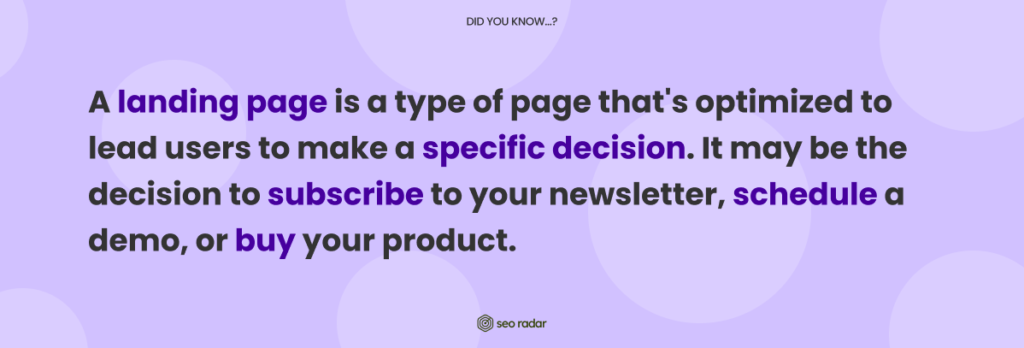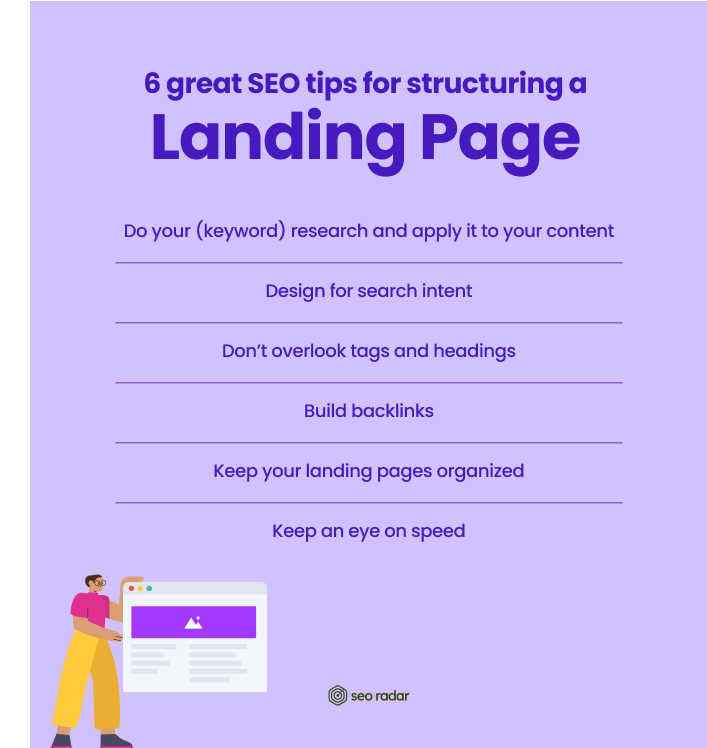In this guide, we’ll explore what landing pages are for, and how to structure a landing page for SEO. We’ll also share some basic tips and tricks you need to know to optimize for conversions.
Let’s dive in.
What Is an SEO Landing Page?
A landing page is a type of page that’s optimized to lead users to make a specific decision. It may be the decision to subscribe to your newsletter, schedule a demo, or buy your product.
In landing pages, everything’s designed to:
- Help the user understand the benefits behind converting
- Give key info about the product, service, or asset being offered
- Answer common questions
- Give them a simple way to move forward, with as little friction as possible
Landing pages are often the destination where users “land” after clicking on a paid ad. But this type of page can also do a lot for your organic traffic. If one of your landing pages ranks for a keyword, when a user enters your website through the SERPs, they’ll find a sharp message and a clear CTA. In that case, your landing page will be introducing your brand in a powerful way, to someone who’s looking for what you have to offer.
How to Structure a Landing Page For SEO
Landing pages are often crafted in the context of pay-per-click campaigns. But, when you take a look at SEO best practices, it’s easy to assume that SEO is the backbone of a good landing page.
Smooth UX, speed, and relevant copy are key elements of a 360° SEO strategy. And that’s exactly what an effective landing page is made of.
In this section, we’ll share some tips for creating great landing pages that rank organically.
We suggest you:
- Do your (keyword) research and apply it to your content
- Design for search intent
- Don’t overlook tags and headings
- Build backlinks
- Keep your landing pages organized
- Keep an eye on speed
Let’s dive in.
Use Keywords to Structure your Content
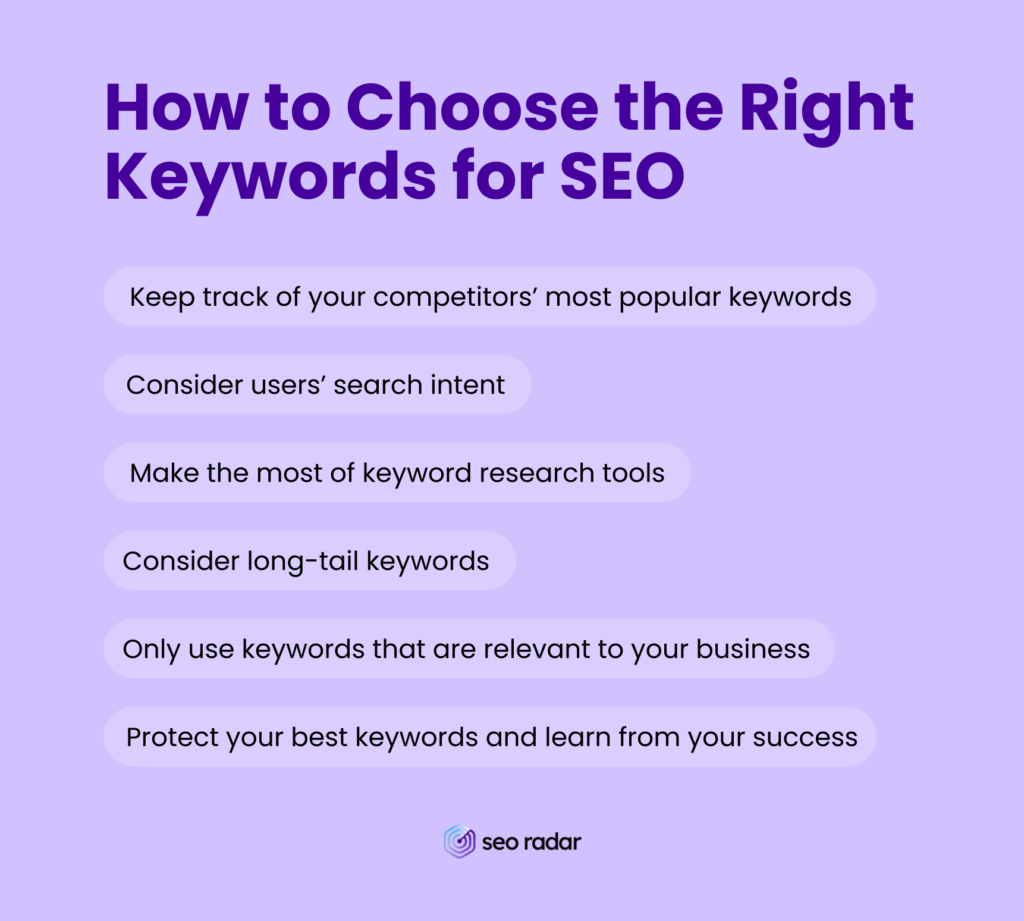
Whether your landing page will be found by the right audience will partially depend on which keywords you choose to target. But some are more useful than others.
When doing keyword research, it’s easy to gravitate towards high-competition, high-volume search queries. But, especially for newcomers, this can be a mistake.
Don’t be afraid to target keywords with lower search volumes, lower competition, and very precise search intent.
Once you’ve got your focus keyword figured out, take a look at long-tail keywords and related searches. Check out rich snippets as well.
In short, use your keyword research as an opportunity to understand what your user is looking for. This will help you discover which common questions they have, and what’s preventing them from moving forward with your competitors. Combine this research with insight into your competitors’ landing pages.
The goal is to craft a landing page structure that addresses each of your customers’ needs and concerns in a competitive way while targeting the terms they’re typing into the Google search bar.
Design for Search Intent
The most successful landing pages engage users as if they were having a conversation with them. Every time the user scrolls down instead of clicking on the CTA, they let you know that they haven’t been convinced yet. So, the next section should include more information that addresses their objections.
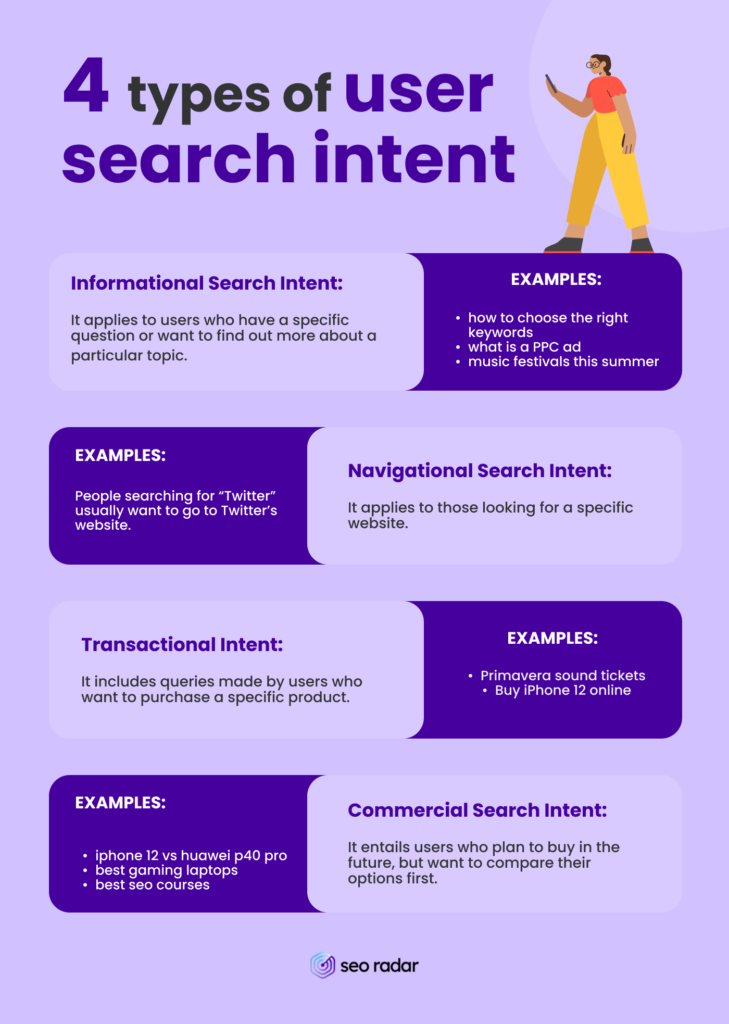
For instance, if the user has already received tons of detailed insight about your product’s use cases, benefits, and features, and still hasn’t decided to move forward, it’s likely that they need to know that this option has already worked for someone else. So, when they scroll down, they should find social proof.
There are many ways to decide how to organize your landing page’s components. As we’ll discuss later in this article, whatever structure you decide may not be definitive. After your landing page goes live, you should start gathering user insights that enable you to rearrange and rethink the page to make it more effective. Making consistent, user-focused changes based on research is a landing page best practice
However, understanding your users’ search intent can help you decide what components are essential to your landing page, and where to include them.
For example, if the section of your audience you’re targeting is looking for “[your product] vs. [your competitor’s product]”, they’re at the consideration stage of their journey. They know they have a need, and they know how to solve it, but they’re unsure about which option is most suitable.
In that case, your landing page could focus on that comparison, and include:
- A hero section where you synthesize your product’s advantages
- A testimonial from a client that transitioned from your competitor to your product
- A synthesis of your value proposition in a few paragraphs
- A section describing the key features that make you the best option
- A comparison chart comparing these features to your competitor’s
- Social proof: The number of users your platform currently has
- A final call-to-action (CTA)
For a smooth and intuitive user experience, each of these sections should be enriched by relevant visuals, and alternated with CTAs.
Don’t Overlook Tags & Headings
SEO isn’t just about including the right keywords on your page. There are some on-page elements that the average user won’t see, as well as some off-page elements, that will impact your SEO. These elements will also have an effect on your landing page’s conversion power.
For instance, your title tag and meta description will let users know what your offer is about and what its competitive advantages are, even before they visit your site. Not having them properly set will affect Google’s ability to understand what your page is about. And, it will also force the search engine to automatically generate your metatags for you. These metatags may not be appealing at all.
To help you cover some basic bases, here’s a short SEO checklist.
Make sure you have:
- A relevant title tag
- A compelling meta description
- Properly set headings
- Alt tags for your images
Title tag – Keep your meta title short and include your target keyword. It’s convenient to place the keyword as close to the beginning of the title as possible. That way, users will detect that the content is relevant to them without much effort. Don’t forget to finish your title with a hyphen and your site’s name. That way, users will know which site they’ll be visiting.
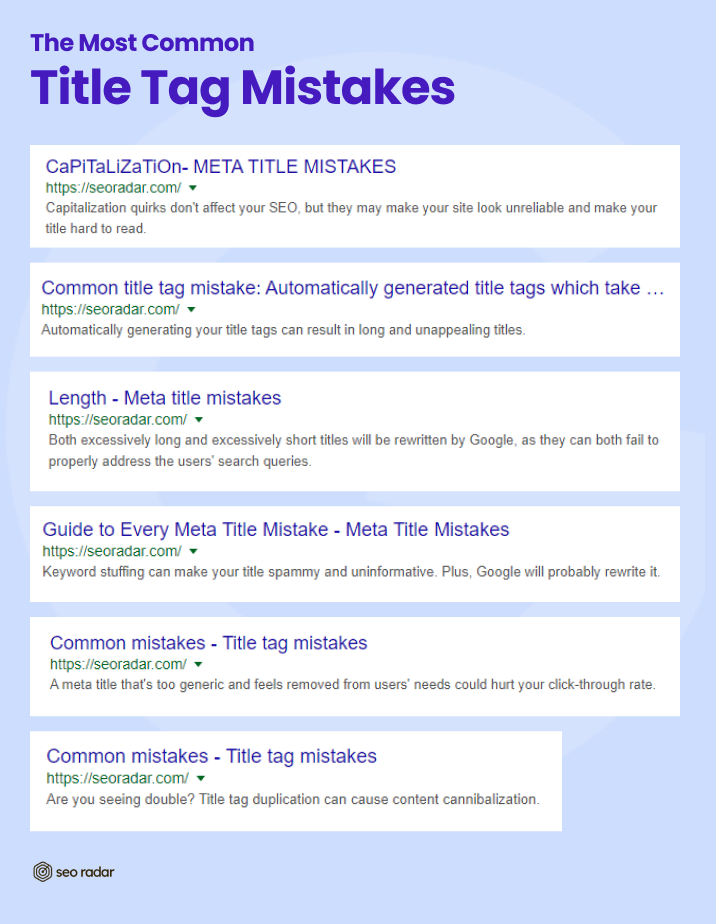
Meta description – Affirm your offer’s value with a clear meta description. Be concise and direct. And make sure you’re not exceeding Google’s character count. You can check whether your meta title and description are formatted correctly on MetaTags.io
Headings – Include your focus keyword in your main title, and make sure it’s an H1 tag. We recommend only using one H1 per page. The rest of the content should be divided up with H2 and H3 tags. Use secondary keywords on your subheadings so users know what each section is about before they read through it.
Alt tags – Search engine robots can’t understand visual content yet. They need some help. Use your alt tag as a short description of what your images represent. And, when relevant, don’t forget to include your target keyword. That way, you’ll help Google index your visual material. In addition, an alt tag is also helpful for visually impaired users, as screen readers will read them aloud when the user navigates to the image.
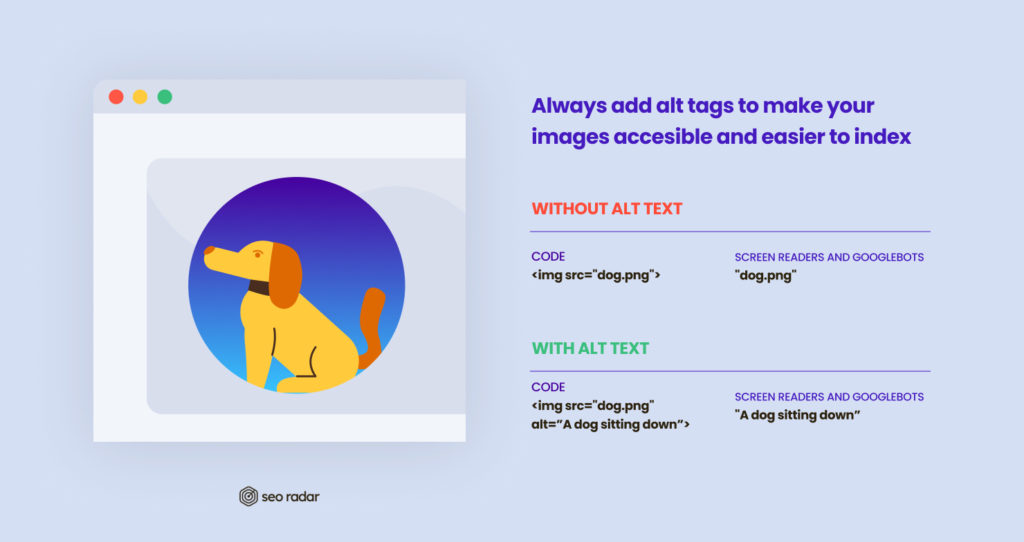
Have a Link Building Strategy
Landing pages are designed to increase conversions, so it’s only natural that they’re competitive. In this context, backlinks are more important than ever. Both as a ranking factor and as a way to get more users to visit your landing page.
Offering original and valuable content is the best strategy for getting others to link to you. But, how can you achieve that for a transactional page?
If your landing page focuses on getting users to download a lead magnet, getting backlinks for it won’t be so hard. For instance, you can share this resource with bloggers, and invite them to include a link to it, as a way to provide extra value to their readers. But, what about other types of pages?
You can make it easier to get quality backlinks by including shareable material, such as useful infographics and stats. On the other hand, don’t underestimate the power of internal linking. Invite users to visit your landing page, whenever it’s relevant.
Interested in getting more backlinks? Visit our link-building strategy guide to learn more.
Keep Your Landing Pages Organized
Should your landing pages be a seamless part of your site? Or should they be isolated in a subdomain?
Where you host your landing page matters. Just like hosting your blog on a subdirectory is better for SEO than hosting it on a subdomain, we recommend you host your landing pages within your site. Otherwise, you’ll be unnecessarily diluting your SEO efforts. Keep in mind that your subdomain and your root domain would be seen as separate entities by Google.
Choosing where to host your landing page is just the start. Make sure you store your landing pages in a location that makes sense. For instance, you could keep them in a subdirectory, with a readable and self-explanatory name. That will help you keep your sitemap tidy and scalable.
Nevertheless, don’t neglect the slug either. Make sure it’s as clear and short as possible. For instance, let’s say you’re an SEO agency creating a landing page for their landing page optimization services. Your landing page’s URL could be:
https://agency.com/services/landing-page-optimization
A readable URL is memorable and prevents broken links resulting from misspellings.
Keep an Eye on Speed
Loading speed is a key ranking factor for search engines. A fast-loading site is on the right track to offering a good user experience. Consequently, it’s less likely to have a high bounce rate, and more likely to have a higher dwell time, than its slow counterparts.
Although Google wants pages to load in less than half a second, if your landing page loads in 1.7-2.9 seconds, it’s already faster than more than 50% of the web.
Worried about your performance? Google PageSpeed is an excellent tool for starters.
Our Favorite Landing Page SEO Best Practice: Optimize After Launch
The average landing page has a conversion rate of 4.02%, but a competitive conversion rate is around 10%. What’s the reason behind this gap?
Simple: Most companies publish their landing pages, and never update them. So, they never build on previous success or optimize underperforming pages.
It may be easy to know if your landing page is working. At the end of the day, you just have to log into your CRM and see how many new newsletter subscribers, demo requests, or new signups you’ve got. But, how can you figure out why a landing page underperforms? How can you recognize patterns that can help you create more relevant pages in the future?
A very effective way to do that is through optimization tools. For instance, with a tool like Hotjar, you can add a heatmap to your landing pages. A heatmap will let you know which elements of your page users interact with, and how often. So, for instance, a heatmap will let you know which one of your CTAs users click the most.
On the other hand, Google Analytics has its own tool for tracking on-site user behavior. It’s called “event tracking” and you can set it up for free, with just a few lines of code.
Gathering this kind of data and using it, can put your site far ahead of the competition. At the end of the day, Google favors content that meets users’ needs best. And Google prefers pages and posts that are constantly being updated and refined to that end. With better landing pages, you’ll get higher dwell time, a lower bounce rate, and all the signals that will reward you with a high SERP position.
Protect your Best Landing Pages
In this post, we shared 7 tips on how to structure a landing page for SEO. While we tend to focus only on what the user sees, SEO problems can arise from the code behind the scenes. But monitoring the source code of every page on your website takes too much energy and time. SEORadar solves this problem.
SEORadar is a technical SEO tool that keeps an eye on your code, so you don’t have to. With SEORadar you can perform automated and customized crawls of your entire codebase (or just key pages), and get notifications of any code changes that could impact your SERP positioning. That way, you can fix issues before they have an impact.
Stay on top of your landing pages with SEORadar. Request a demo or start a free trial.


